Wine and Beverage Management: A Comparative Study of Tasmania and France
VerifiedAdded on 2023/06/11
|10
|2533
|249
AI Summary
The paper evaluates the wine regions of Tasmania and France, their history, styles, and legislative requirements. It discusses the characteristics, growing techniques, harvesting, and production methods of grape varieties. The paper also provides an overview of the factors that affect the quality of wines in both regions.
Contribute Materials
Your contribution can guide someone’s learning journey. Share your
documents today.
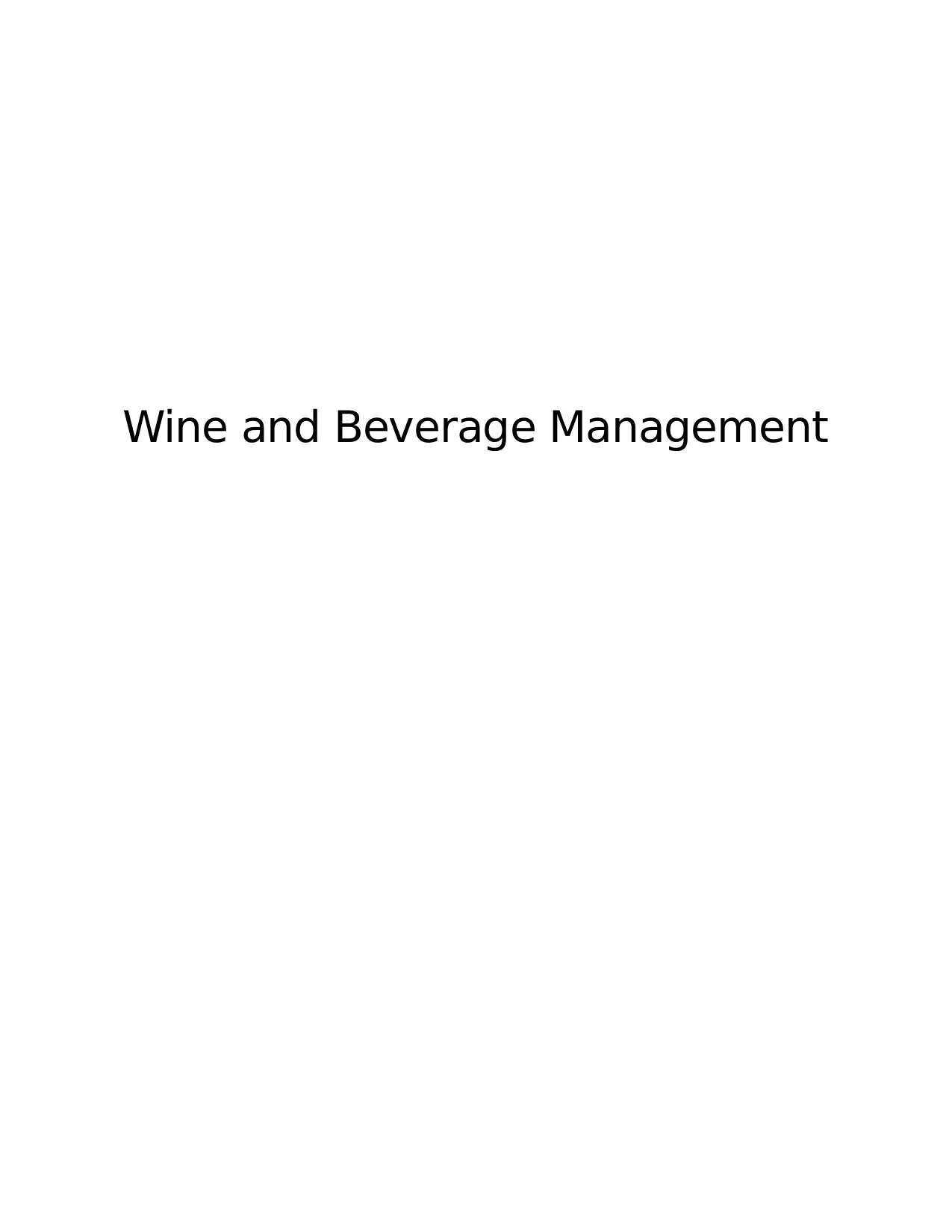
Wine and Beverage Management
Secure Best Marks with AI Grader
Need help grading? Try our AI Grader for instant feedback on your assignments.
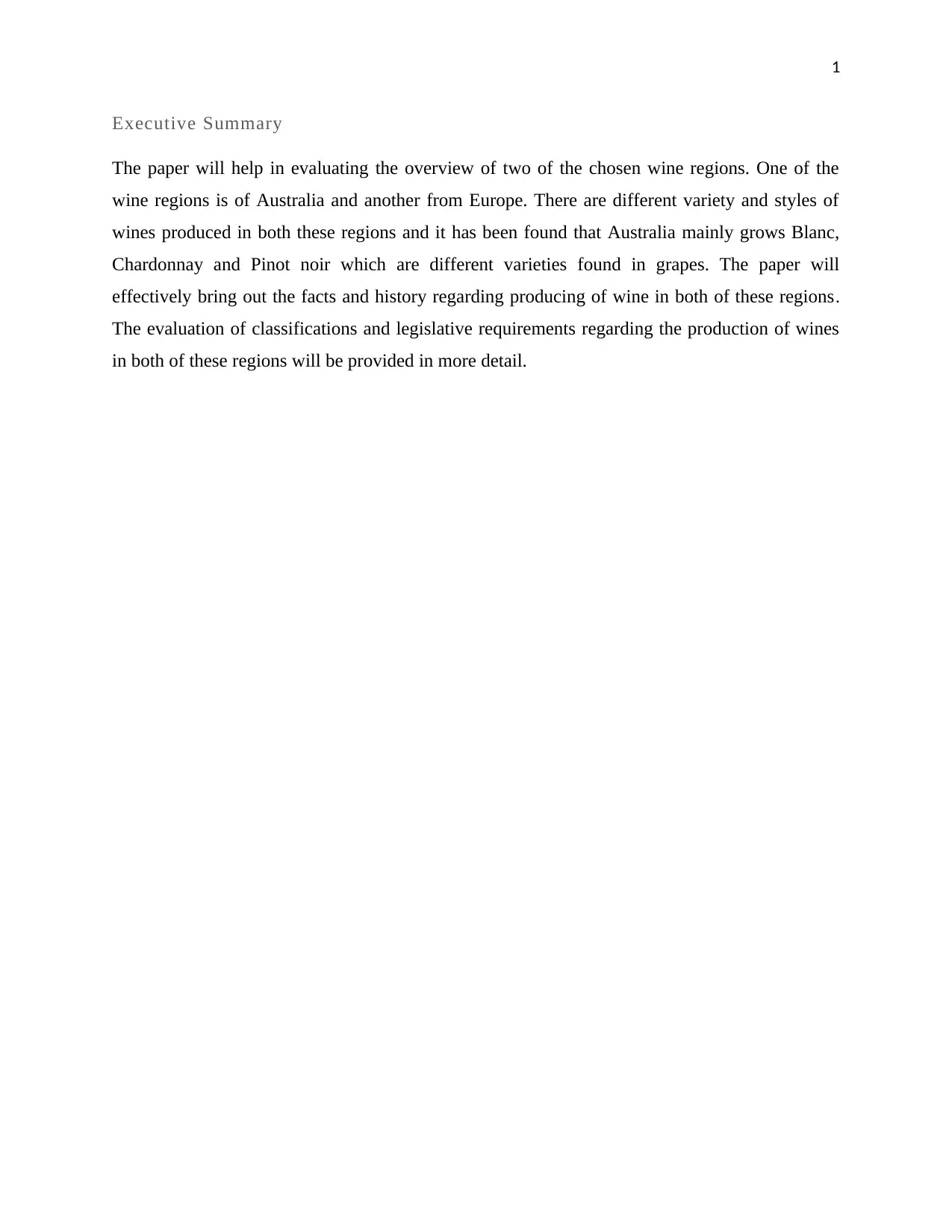
1
Executive Summary
The paper will help in evaluating the overview of two of the chosen wine regions. One of the
wine regions is of Australia and another from Europe. There are different variety and styles of
wines produced in both these regions and it has been found that Australia mainly grows Blanc,
Chardonnay and Pinot noir which are different varieties found in grapes. The paper will
effectively bring out the facts and history regarding producing of wine in both of these regions.
The evaluation of classifications and legislative requirements regarding the production of wines
in both of these regions will be provided in more detail.
Executive Summary
The paper will help in evaluating the overview of two of the chosen wine regions. One of the
wine regions is of Australia and another from Europe. There are different variety and styles of
wines produced in both these regions and it has been found that Australia mainly grows Blanc,
Chardonnay and Pinot noir which are different varieties found in grapes. The paper will
effectively bring out the facts and history regarding producing of wine in both of these regions.
The evaluation of classifications and legislative requirements regarding the production of wines
in both of these regions will be provided in more detail.
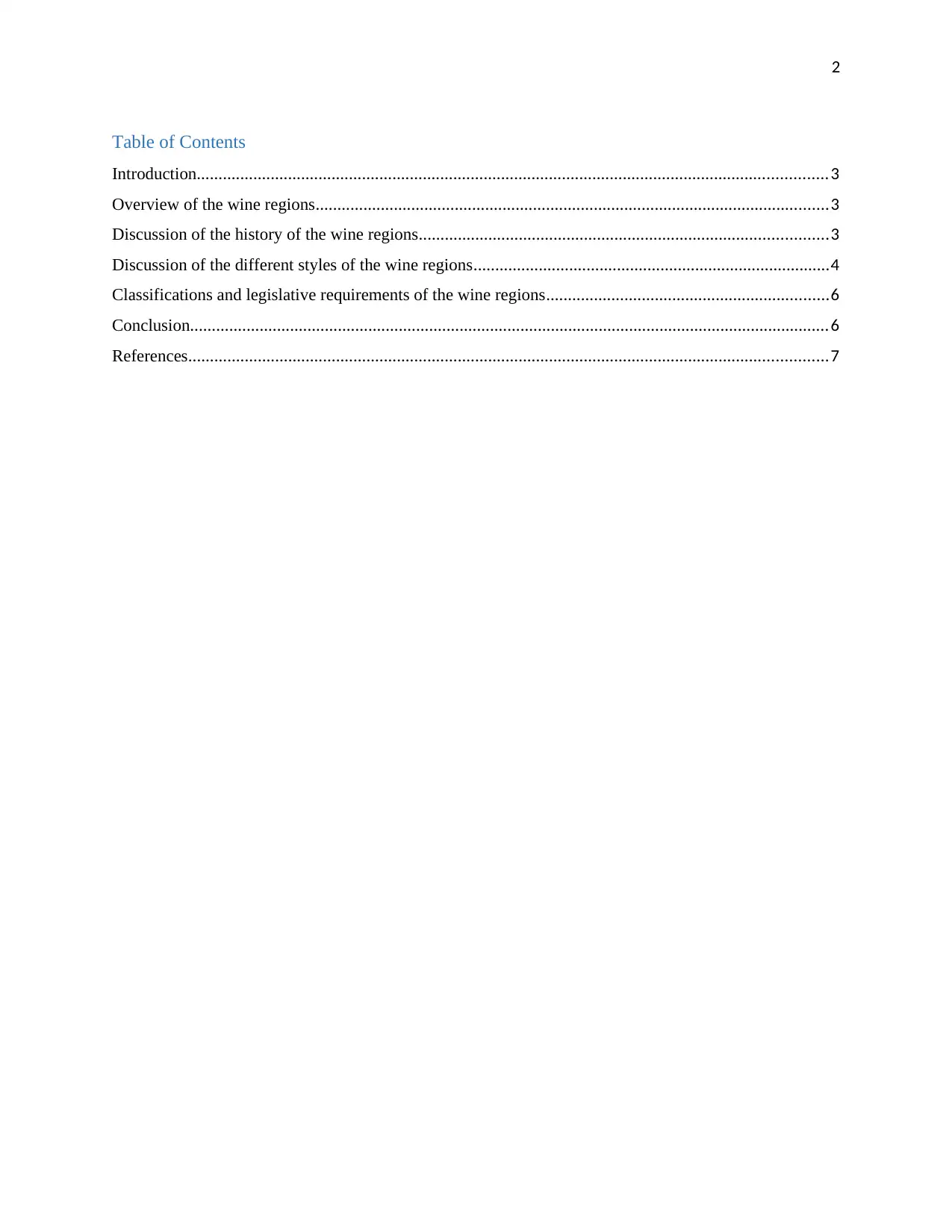
2
Table of Contents
Introduction.................................................................................................................................................3
Overview of the wine regions......................................................................................................................3
Discussion of the history of the wine regions..............................................................................................3
Discussion of the different styles of the wine regions..................................................................................4
Classifications and legislative requirements of the wine regions.................................................................6
Conclusion...................................................................................................................................................6
References...................................................................................................................................................7
Table of Contents
Introduction.................................................................................................................................................3
Overview of the wine regions......................................................................................................................3
Discussion of the history of the wine regions..............................................................................................3
Discussion of the different styles of the wine regions..................................................................................4
Classifications and legislative requirements of the wine regions.................................................................6
Conclusion...................................................................................................................................................6
References...................................................................................................................................................7
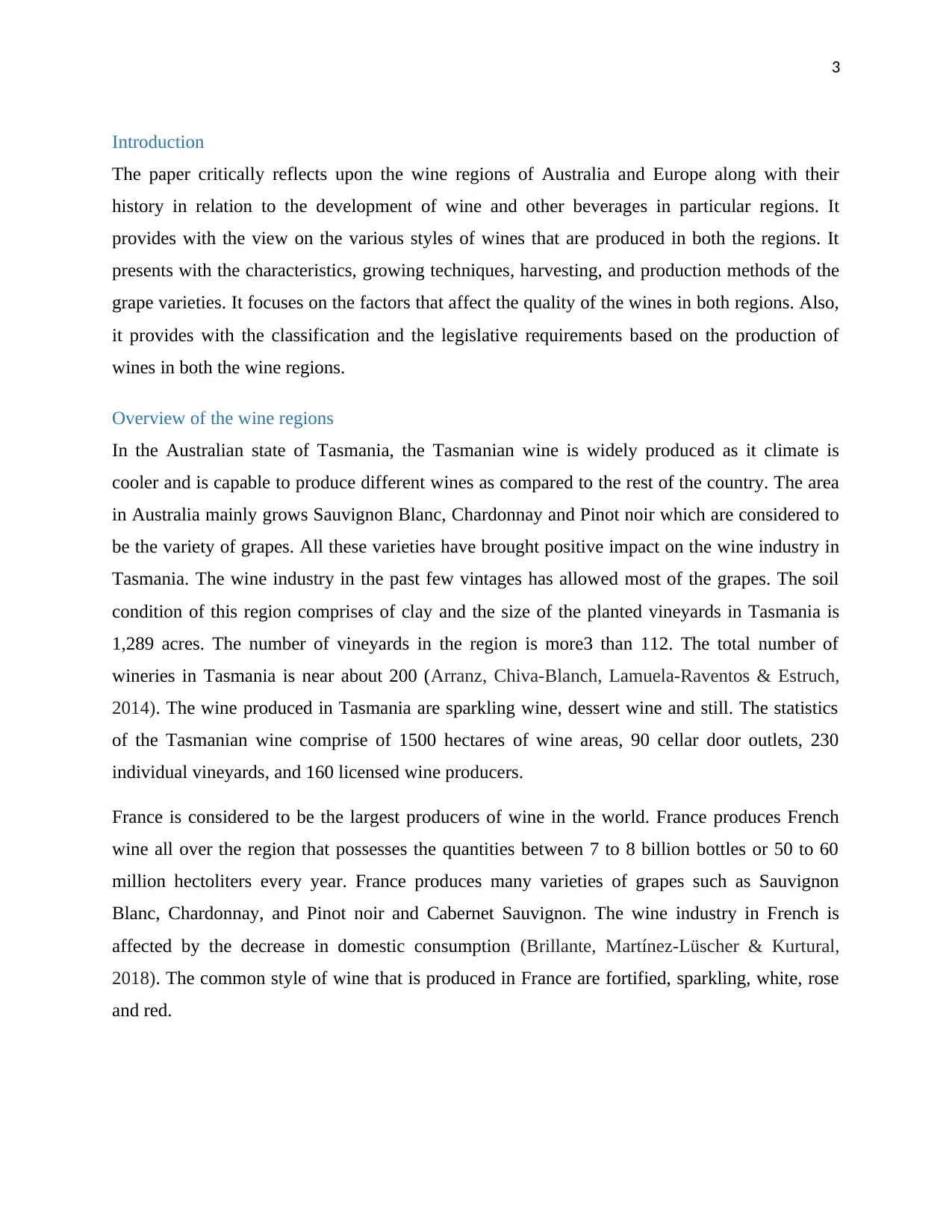
3
Introduction
The paper critically reflects upon the wine regions of Australia and Europe along with their
history in relation to the development of wine and other beverages in particular regions. It
provides with the view on the various styles of wines that are produced in both the regions. It
presents with the characteristics, growing techniques, harvesting, and production methods of the
grape varieties. It focuses on the factors that affect the quality of the wines in both regions. Also,
it provides with the classification and the legislative requirements based on the production of
wines in both the wine regions.
Overview of the wine regions
In the Australian state of Tasmania, the Tasmanian wine is widely produced as it climate is
cooler and is capable to produce different wines as compared to the rest of the country. The area
in Australia mainly grows Sauvignon Blanc, Chardonnay and Pinot noir which are considered to
be the variety of grapes. All these varieties have brought positive impact on the wine industry in
Tasmania. The wine industry in the past few vintages has allowed most of the grapes. The soil
condition of this region comprises of clay and the size of the planted vineyards in Tasmania is
1,289 acres. The number of vineyards in the region is more3 than 112. The total number of
wineries in Tasmania is near about 200 (Arranz, Chiva-Blanch, Lamuela-Raventos & Estruch,
2014). The wine produced in Tasmania are sparkling wine, dessert wine and still. The statistics
of the Tasmanian wine comprise of 1500 hectares of wine areas, 90 cellar door outlets, 230
individual vineyards, and 160 licensed wine producers.
France is considered to be the largest producers of wine in the world. France produces French
wine all over the region that possesses the quantities between 7 to 8 billion bottles or 50 to 60
million hectoliters every year. France produces many varieties of grapes such as Sauvignon
Blanc, Chardonnay, and Pinot noir and Cabernet Sauvignon. The wine industry in French is
affected by the decrease in domestic consumption (Brillante, Martínez-Lüscher & Kurtural,
2018). The common style of wine that is produced in France are fortified, sparkling, white, rose
and red.
Introduction
The paper critically reflects upon the wine regions of Australia and Europe along with their
history in relation to the development of wine and other beverages in particular regions. It
provides with the view on the various styles of wines that are produced in both the regions. It
presents with the characteristics, growing techniques, harvesting, and production methods of the
grape varieties. It focuses on the factors that affect the quality of the wines in both regions. Also,
it provides with the classification and the legislative requirements based on the production of
wines in both the wine regions.
Overview of the wine regions
In the Australian state of Tasmania, the Tasmanian wine is widely produced as it climate is
cooler and is capable to produce different wines as compared to the rest of the country. The area
in Australia mainly grows Sauvignon Blanc, Chardonnay and Pinot noir which are considered to
be the variety of grapes. All these varieties have brought positive impact on the wine industry in
Tasmania. The wine industry in the past few vintages has allowed most of the grapes. The soil
condition of this region comprises of clay and the size of the planted vineyards in Tasmania is
1,289 acres. The number of vineyards in the region is more3 than 112. The total number of
wineries in Tasmania is near about 200 (Arranz, Chiva-Blanch, Lamuela-Raventos & Estruch,
2014). The wine produced in Tasmania are sparkling wine, dessert wine and still. The statistics
of the Tasmanian wine comprise of 1500 hectares of wine areas, 90 cellar door outlets, 230
individual vineyards, and 160 licensed wine producers.
France is considered to be the largest producers of wine in the world. France produces French
wine all over the region that possesses the quantities between 7 to 8 billion bottles or 50 to 60
million hectoliters every year. France produces many varieties of grapes such as Sauvignon
Blanc, Chardonnay, and Pinot noir and Cabernet Sauvignon. The wine industry in French is
affected by the decrease in domestic consumption (Brillante, Martínez-Lüscher & Kurtural,
2018). The common style of wine that is produced in France are fortified, sparkling, white, rose
and red.
Secure Best Marks with AI Grader
Need help grading? Try our AI Grader for instant feedback on your assignments.
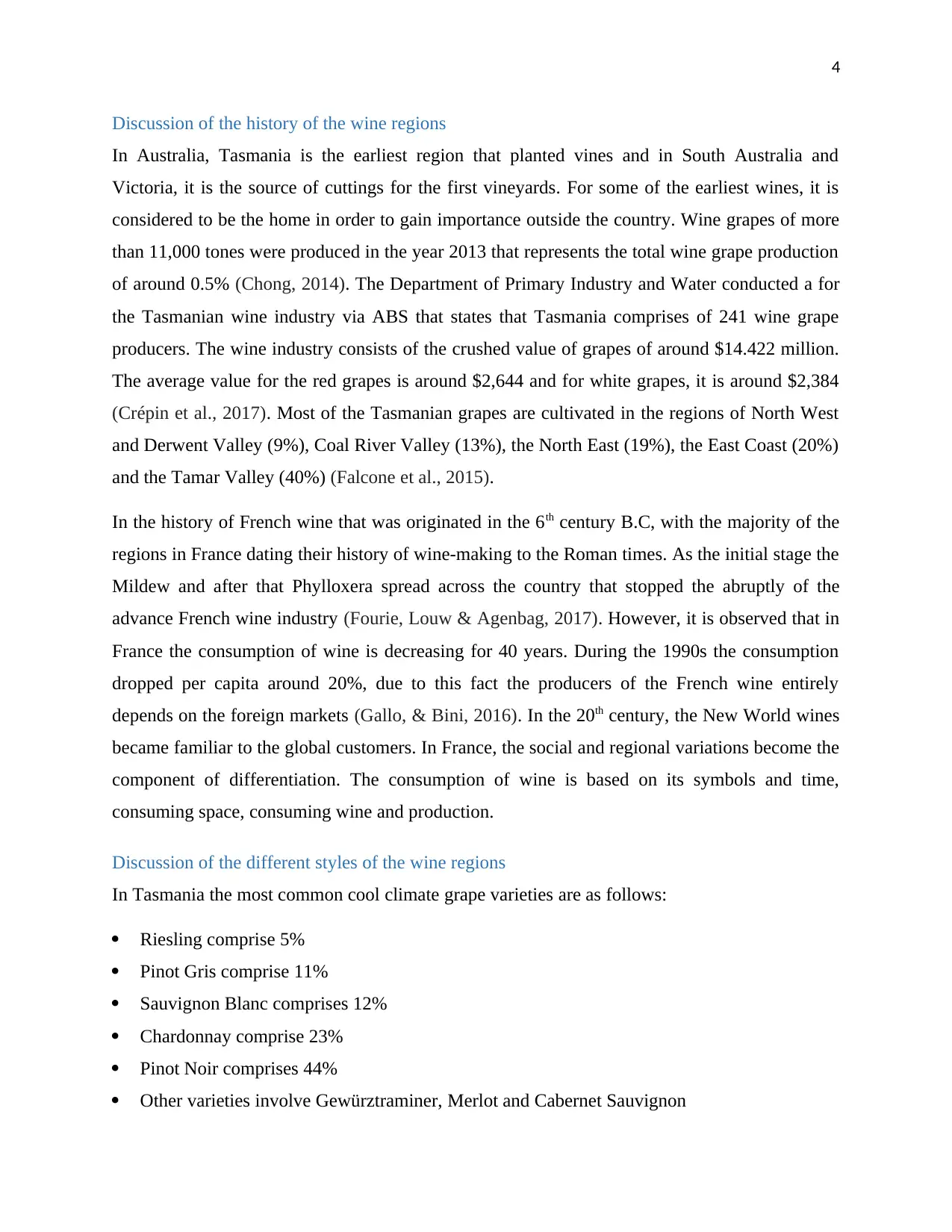
4
Discussion of the history of the wine regions
In Australia, Tasmania is the earliest region that planted vines and in South Australia and
Victoria, it is the source of cuttings for the first vineyards. For some of the earliest wines, it is
considered to be the home in order to gain importance outside the country. Wine grapes of more
than 11,000 tones were produced in the year 2013 that represents the total wine grape production
of around 0.5% (Chong, 2014). The Department of Primary Industry and Water conducted a for
the Tasmanian wine industry via ABS that states that Tasmania comprises of 241 wine grape
producers. The wine industry consists of the crushed value of grapes of around $14.422 million.
The average value for the red grapes is around $2,644 and for white grapes, it is around $2,384
(Crépin et al., 2017). Most of the Tasmanian grapes are cultivated in the regions of North West
and Derwent Valley (9%), Coal River Valley (13%), the North East (19%), the East Coast (20%)
and the Tamar Valley (40%) (Falcone et al., 2015).
In the history of French wine that was originated in the 6th century B.C, with the majority of the
regions in France dating their history of wine-making to the Roman times. As the initial stage the
Mildew and after that Phylloxera spread across the country that stopped the abruptly of the
advance French wine industry (Fourie, Louw & Agenbag, 2017). However, it is observed that in
France the consumption of wine is decreasing for 40 years. During the 1990s the consumption
dropped per capita around 20%, due to this fact the producers of the French wine entirely
depends on the foreign markets (Gallo, & Bini, 2016). In the 20th century, the New World wines
became familiar to the global customers. In France, the social and regional variations become the
component of differentiation. The consumption of wine is based on its symbols and time,
consuming space, consuming wine and production.
Discussion of the different styles of the wine regions
In Tasmania the most common cool climate grape varieties are as follows:
Riesling comprise 5%
Pinot Gris comprise 11%
Sauvignon Blanc comprises 12%
Chardonnay comprise 23%
Pinot Noir comprises 44%
Other varieties involve Gewürztraminer, Merlot and Cabernet Sauvignon
Discussion of the history of the wine regions
In Australia, Tasmania is the earliest region that planted vines and in South Australia and
Victoria, it is the source of cuttings for the first vineyards. For some of the earliest wines, it is
considered to be the home in order to gain importance outside the country. Wine grapes of more
than 11,000 tones were produced in the year 2013 that represents the total wine grape production
of around 0.5% (Chong, 2014). The Department of Primary Industry and Water conducted a for
the Tasmanian wine industry via ABS that states that Tasmania comprises of 241 wine grape
producers. The wine industry consists of the crushed value of grapes of around $14.422 million.
The average value for the red grapes is around $2,644 and for white grapes, it is around $2,384
(Crépin et al., 2017). Most of the Tasmanian grapes are cultivated in the regions of North West
and Derwent Valley (9%), Coal River Valley (13%), the North East (19%), the East Coast (20%)
and the Tamar Valley (40%) (Falcone et al., 2015).
In the history of French wine that was originated in the 6th century B.C, with the majority of the
regions in France dating their history of wine-making to the Roman times. As the initial stage the
Mildew and after that Phylloxera spread across the country that stopped the abruptly of the
advance French wine industry (Fourie, Louw & Agenbag, 2017). However, it is observed that in
France the consumption of wine is decreasing for 40 years. During the 1990s the consumption
dropped per capita around 20%, due to this fact the producers of the French wine entirely
depends on the foreign markets (Gallo, & Bini, 2016). In the 20th century, the New World wines
became familiar to the global customers. In France, the social and regional variations become the
component of differentiation. The consumption of wine is based on its symbols and time,
consuming space, consuming wine and production.
Discussion of the different styles of the wine regions
In Tasmania the most common cool climate grape varieties are as follows:
Riesling comprise 5%
Pinot Gris comprise 11%
Sauvignon Blanc comprises 12%
Chardonnay comprise 23%
Pinot Noir comprises 44%
Other varieties involve Gewürztraminer, Merlot and Cabernet Sauvignon
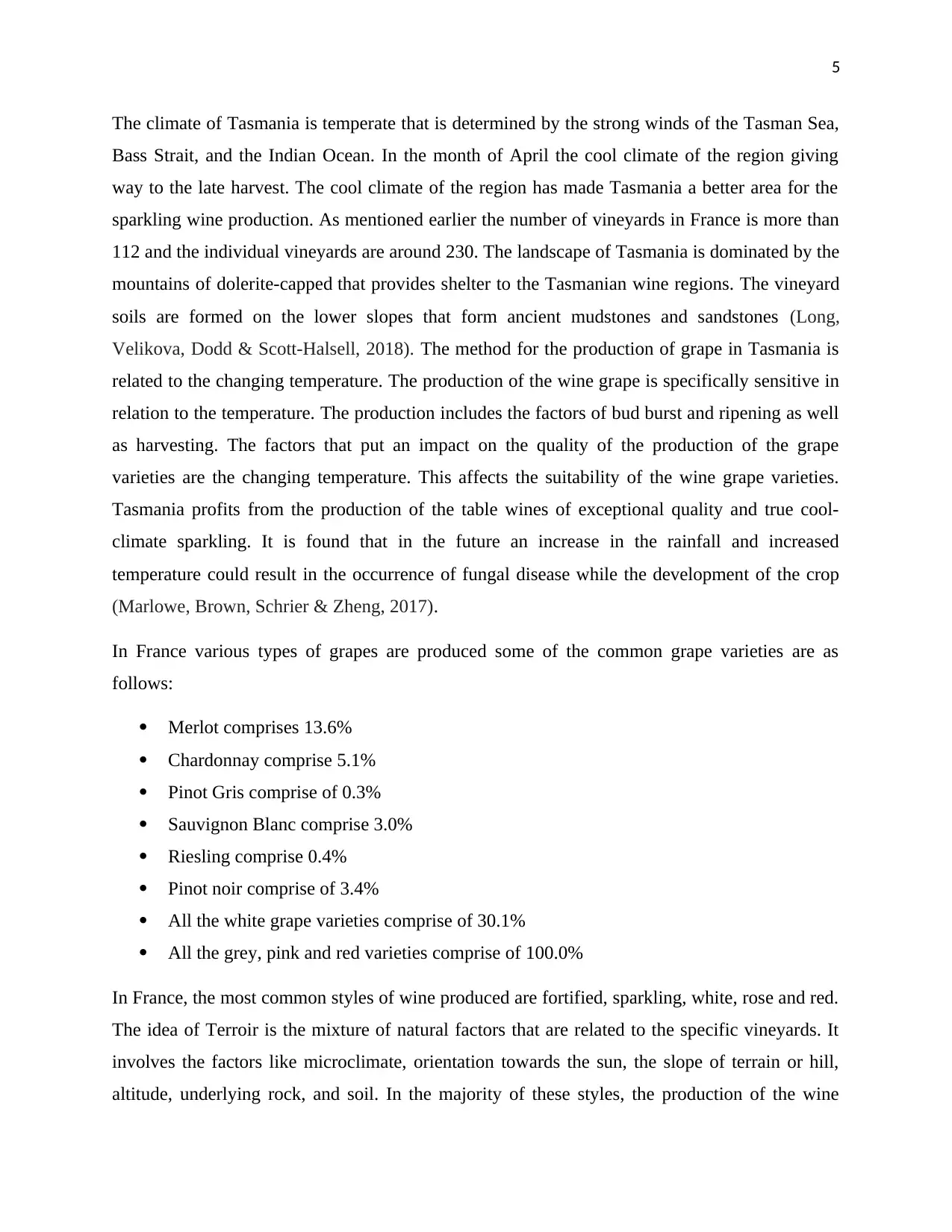
5
The climate of Tasmania is temperate that is determined by the strong winds of the Tasman Sea,
Bass Strait, and the Indian Ocean. In the month of April the cool climate of the region giving
way to the late harvest. The cool climate of the region has made Tasmania a better area for the
sparkling wine production. As mentioned earlier the number of vineyards in France is more than
112 and the individual vineyards are around 230. The landscape of Tasmania is dominated by the
mountains of dolerite-capped that provides shelter to the Tasmanian wine regions. The vineyard
soils are formed on the lower slopes that form ancient mudstones and sandstones (Long,
Velikova, Dodd & Scott-Halsell, 2018). The method for the production of grape in Tasmania is
related to the changing temperature. The production of the wine grape is specifically sensitive in
relation to the temperature. The production includes the factors of bud burst and ripening as well
as harvesting. The factors that put an impact on the quality of the production of the grape
varieties are the changing temperature. This affects the suitability of the wine grape varieties.
Tasmania profits from the production of the table wines of exceptional quality and true cool-
climate sparkling. It is found that in the future an increase in the rainfall and increased
temperature could result in the occurrence of fungal disease while the development of the crop
(Marlowe, Brown, Schrier & Zheng, 2017).
In France various types of grapes are produced some of the common grape varieties are as
follows:
Merlot comprises 13.6%
Chardonnay comprise 5.1%
Pinot Gris comprise of 0.3%
Sauvignon Blanc comprise 3.0%
Riesling comprise 0.4%
Pinot noir comprise of 3.4%
All the white grape varieties comprise of 30.1%
All the grey, pink and red varieties comprise of 100.0%
In France, the most common styles of wine produced are fortified, sparkling, white, rose and red.
The idea of Terroir is the mixture of natural factors that are related to the specific vineyards. It
involves the factors like microclimate, orientation towards the sun, the slope of terrain or hill,
altitude, underlying rock, and soil. In the majority of these styles, the production of the wine
The climate of Tasmania is temperate that is determined by the strong winds of the Tasman Sea,
Bass Strait, and the Indian Ocean. In the month of April the cool climate of the region giving
way to the late harvest. The cool climate of the region has made Tasmania a better area for the
sparkling wine production. As mentioned earlier the number of vineyards in France is more than
112 and the individual vineyards are around 230. The landscape of Tasmania is dominated by the
mountains of dolerite-capped that provides shelter to the Tasmanian wine regions. The vineyard
soils are formed on the lower slopes that form ancient mudstones and sandstones (Long,
Velikova, Dodd & Scott-Halsell, 2018). The method for the production of grape in Tasmania is
related to the changing temperature. The production of the wine grape is specifically sensitive in
relation to the temperature. The production includes the factors of bud burst and ripening as well
as harvesting. The factors that put an impact on the quality of the production of the grape
varieties are the changing temperature. This affects the suitability of the wine grape varieties.
Tasmania profits from the production of the table wines of exceptional quality and true cool-
climate sparkling. It is found that in the future an increase in the rainfall and increased
temperature could result in the occurrence of fungal disease while the development of the crop
(Marlowe, Brown, Schrier & Zheng, 2017).
In France various types of grapes are produced some of the common grape varieties are as
follows:
Merlot comprises 13.6%
Chardonnay comprise 5.1%
Pinot Gris comprise of 0.3%
Sauvignon Blanc comprise 3.0%
Riesling comprise 0.4%
Pinot noir comprise of 3.4%
All the white grape varieties comprise of 30.1%
All the grey, pink and red varieties comprise of 100.0%
In France, the most common styles of wine produced are fortified, sparkling, white, rose and red.
The idea of Terroir is the mixture of natural factors that are related to the specific vineyards. It
involves the factors like microclimate, orientation towards the sun, the slope of terrain or hill,
altitude, underlying rock, and soil. In the majority of these styles, the production of the wine
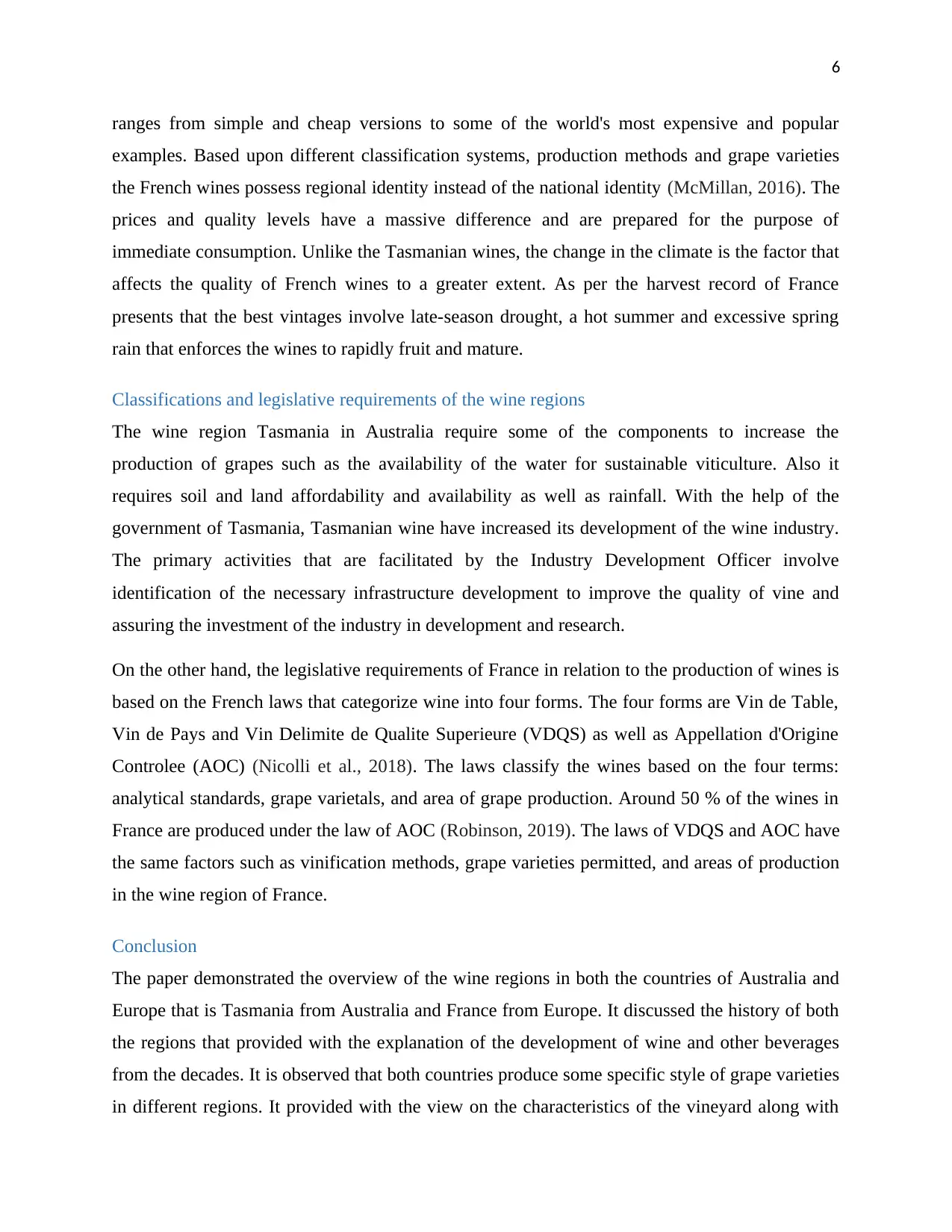
6
ranges from simple and cheap versions to some of the world's most expensive and popular
examples. Based upon different classification systems, production methods and grape varieties
the French wines possess regional identity instead of the national identity (McMillan, 2016). The
prices and quality levels have a massive difference and are prepared for the purpose of
immediate consumption. Unlike the Tasmanian wines, the change in the climate is the factor that
affects the quality of French wines to a greater extent. As per the harvest record of France
presents that the best vintages involve late-season drought, a hot summer and excessive spring
rain that enforces the wines to rapidly fruit and mature.
Classifications and legislative requirements of the wine regions
The wine region Tasmania in Australia require some of the components to increase the
production of grapes such as the availability of the water for sustainable viticulture. Also it
requires soil and land affordability and availability as well as rainfall. With the help of the
government of Tasmania, Tasmanian wine have increased its development of the wine industry.
The primary activities that are facilitated by the Industry Development Officer involve
identification of the necessary infrastructure development to improve the quality of vine and
assuring the investment of the industry in development and research.
On the other hand, the legislative requirements of France in relation to the production of wines is
based on the French laws that categorize wine into four forms. The four forms are Vin de Table,
Vin de Pays and Vin Delimite de Qualite Superieure (VDQS) as well as Appellation d'Origine
Controlee (AOC) (Nicolli et al., 2018). The laws classify the wines based on the four terms:
analytical standards, grape varietals, and area of grape production. Around 50 % of the wines in
France are produced under the law of AOC (Robinson, 2019). The laws of VDQS and AOC have
the same factors such as vinification methods, grape varieties permitted, and areas of production
in the wine region of France.
Conclusion
The paper demonstrated the overview of the wine regions in both the countries of Australia and
Europe that is Tasmania from Australia and France from Europe. It discussed the history of both
the regions that provided with the explanation of the development of wine and other beverages
from the decades. It is observed that both countries produce some specific style of grape varieties
in different regions. It provided with the view on the characteristics of the vineyard along with
ranges from simple and cheap versions to some of the world's most expensive and popular
examples. Based upon different classification systems, production methods and grape varieties
the French wines possess regional identity instead of the national identity (McMillan, 2016). The
prices and quality levels have a massive difference and are prepared for the purpose of
immediate consumption. Unlike the Tasmanian wines, the change in the climate is the factor that
affects the quality of French wines to a greater extent. As per the harvest record of France
presents that the best vintages involve late-season drought, a hot summer and excessive spring
rain that enforces the wines to rapidly fruit and mature.
Classifications and legislative requirements of the wine regions
The wine region Tasmania in Australia require some of the components to increase the
production of grapes such as the availability of the water for sustainable viticulture. Also it
requires soil and land affordability and availability as well as rainfall. With the help of the
government of Tasmania, Tasmanian wine have increased its development of the wine industry.
The primary activities that are facilitated by the Industry Development Officer involve
identification of the necessary infrastructure development to improve the quality of vine and
assuring the investment of the industry in development and research.
On the other hand, the legislative requirements of France in relation to the production of wines is
based on the French laws that categorize wine into four forms. The four forms are Vin de Table,
Vin de Pays and Vin Delimite de Qualite Superieure (VDQS) as well as Appellation d'Origine
Controlee (AOC) (Nicolli et al., 2018). The laws classify the wines based on the four terms:
analytical standards, grape varietals, and area of grape production. Around 50 % of the wines in
France are produced under the law of AOC (Robinson, 2019). The laws of VDQS and AOC have
the same factors such as vinification methods, grape varieties permitted, and areas of production
in the wine region of France.
Conclusion
The paper demonstrated the overview of the wine regions in both the countries of Australia and
Europe that is Tasmania from Australia and France from Europe. It discussed the history of both
the regions that provided with the explanation of the development of wine and other beverages
from the decades. It is observed that both countries produce some specific style of grape varieties
in different regions. It provided with the view on the characteristics of the vineyard along with
Paraphrase This Document
Need a fresh take? Get an instant paraphrase of this document with our AI Paraphraser
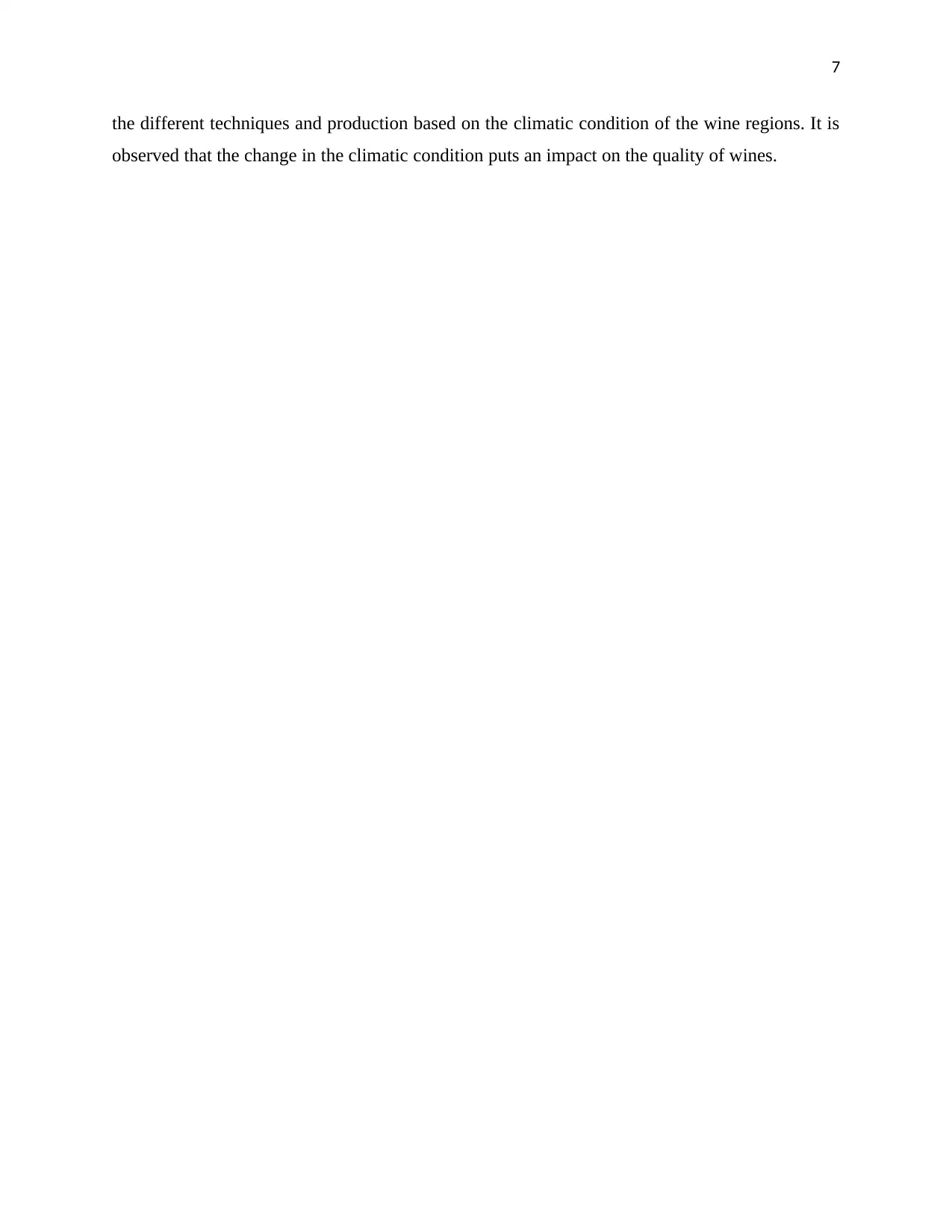
7
the different techniques and production based on the climatic condition of the wine regions. It is
observed that the change in the climatic condition puts an impact on the quality of wines.
the different techniques and production based on the climatic condition of the wine regions. It is
observed that the change in the climatic condition puts an impact on the quality of wines.
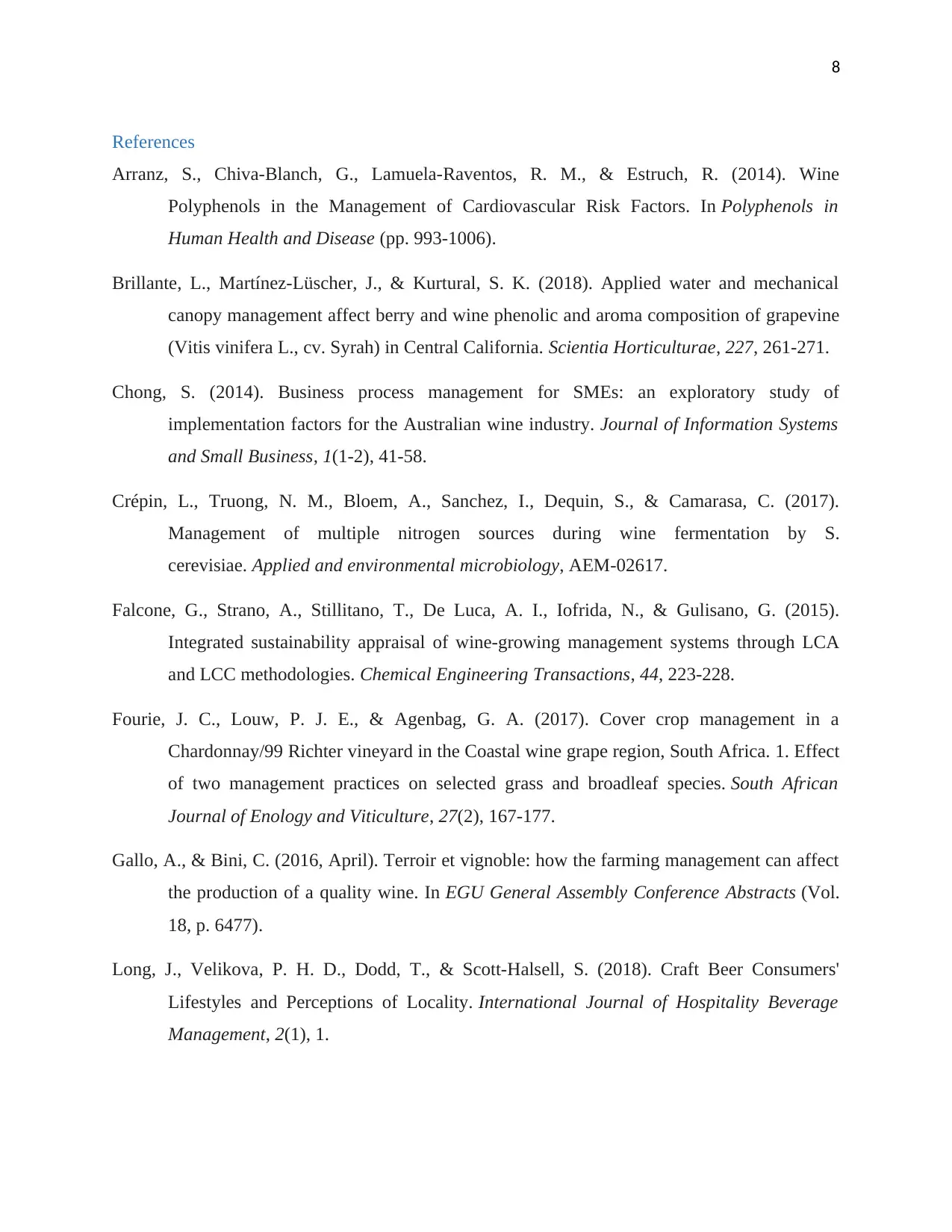
8
References
Arranz, S., Chiva-Blanch, G., Lamuela-Raventos, R. M., & Estruch, R. (2014). Wine
Polyphenols in the Management of Cardiovascular Risk Factors. In Polyphenols in
Human Health and Disease (pp. 993-1006).
Brillante, L., Martínez-Lüscher, J., & Kurtural, S. K. (2018). Applied water and mechanical
canopy management affect berry and wine phenolic and aroma composition of grapevine
(Vitis vinifera L., cv. Syrah) in Central California. Scientia Horticulturae, 227, 261-271.
Chong, S. (2014). Business process management for SMEs: an exploratory study of
implementation factors for the Australian wine industry. Journal of Information Systems
and Small Business, 1(1-2), 41-58.
Crépin, L., Truong, N. M., Bloem, A., Sanchez, I., Dequin, S., & Camarasa, C. (2017).
Management of multiple nitrogen sources during wine fermentation by S.
cerevisiae. Applied and environmental microbiology, AEM-02617.
Falcone, G., Strano, A., Stillitano, T., De Luca, A. I., Iofrida, N., & Gulisano, G. (2015).
Integrated sustainability appraisal of wine-growing management systems through LCA
and LCC methodologies. Chemical Engineering Transactions, 44, 223-228.
Fourie, J. C., Louw, P. J. E., & Agenbag, G. A. (2017). Cover crop management in a
Chardonnay/99 Richter vineyard in the Coastal wine grape region, South Africa. 1. Effect
of two management practices on selected grass and broadleaf species. South African
Journal of Enology and Viticulture, 27(2), 167-177.
Gallo, A., & Bini, C. (2016, April). Terroir et vignoble: how the farming management can affect
the production of a quality wine. In EGU General Assembly Conference Abstracts (Vol.
18, p. 6477).
Long, J., Velikova, P. H. D., Dodd, T., & Scott-Halsell, S. (2018). Craft Beer Consumers'
Lifestyles and Perceptions of Locality. International Journal of Hospitality Beverage
Management, 2(1), 1.
References
Arranz, S., Chiva-Blanch, G., Lamuela-Raventos, R. M., & Estruch, R. (2014). Wine
Polyphenols in the Management of Cardiovascular Risk Factors. In Polyphenols in
Human Health and Disease (pp. 993-1006).
Brillante, L., Martínez-Lüscher, J., & Kurtural, S. K. (2018). Applied water and mechanical
canopy management affect berry and wine phenolic and aroma composition of grapevine
(Vitis vinifera L., cv. Syrah) in Central California. Scientia Horticulturae, 227, 261-271.
Chong, S. (2014). Business process management for SMEs: an exploratory study of
implementation factors for the Australian wine industry. Journal of Information Systems
and Small Business, 1(1-2), 41-58.
Crépin, L., Truong, N. M., Bloem, A., Sanchez, I., Dequin, S., & Camarasa, C. (2017).
Management of multiple nitrogen sources during wine fermentation by S.
cerevisiae. Applied and environmental microbiology, AEM-02617.
Falcone, G., Strano, A., Stillitano, T., De Luca, A. I., Iofrida, N., & Gulisano, G. (2015).
Integrated sustainability appraisal of wine-growing management systems through LCA
and LCC methodologies. Chemical Engineering Transactions, 44, 223-228.
Fourie, J. C., Louw, P. J. E., & Agenbag, G. A. (2017). Cover crop management in a
Chardonnay/99 Richter vineyard in the Coastal wine grape region, South Africa. 1. Effect
of two management practices on selected grass and broadleaf species. South African
Journal of Enology and Viticulture, 27(2), 167-177.
Gallo, A., & Bini, C. (2016, April). Terroir et vignoble: how the farming management can affect
the production of a quality wine. In EGU General Assembly Conference Abstracts (Vol.
18, p. 6477).
Long, J., Velikova, P. H. D., Dodd, T., & Scott-Halsell, S. (2018). Craft Beer Consumers'
Lifestyles and Perceptions of Locality. International Journal of Hospitality Beverage
Management, 2(1), 1.
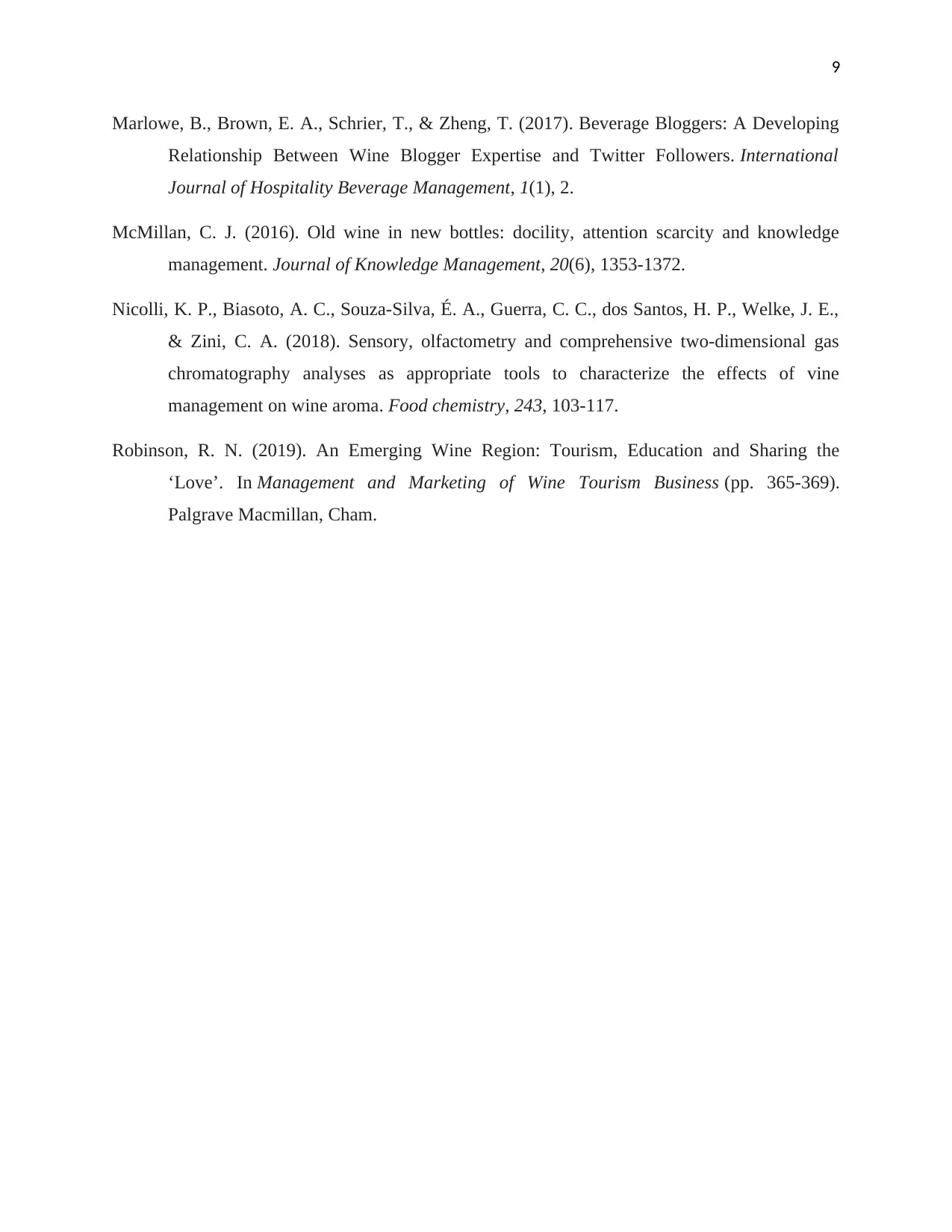
9
Marlowe, B., Brown, E. A., Schrier, T., & Zheng, T. (2017). Beverage Bloggers: A Developing
Relationship Between Wine Blogger Expertise and Twitter Followers. International
Journal of Hospitality Beverage Management, 1(1), 2.
McMillan, C. J. (2016). Old wine in new bottles: docility, attention scarcity and knowledge
management. Journal of Knowledge Management, 20(6), 1353-1372.
Nicolli, K. P., Biasoto, A. C., Souza-Silva, É. A., Guerra, C. C., dos Santos, H. P., Welke, J. E.,
& Zini, C. A. (2018). Sensory, olfactometry and comprehensive two-dimensional gas
chromatography analyses as appropriate tools to characterize the effects of vine
management on wine aroma. Food chemistry, 243, 103-117.
Robinson, R. N. (2019). An Emerging Wine Region: Tourism, Education and Sharing the
‘Love’. In Management and Marketing of Wine Tourism Business (pp. 365-369).
Palgrave Macmillan, Cham.
Marlowe, B., Brown, E. A., Schrier, T., & Zheng, T. (2017). Beverage Bloggers: A Developing
Relationship Between Wine Blogger Expertise and Twitter Followers. International
Journal of Hospitality Beverage Management, 1(1), 2.
McMillan, C. J. (2016). Old wine in new bottles: docility, attention scarcity and knowledge
management. Journal of Knowledge Management, 20(6), 1353-1372.
Nicolli, K. P., Biasoto, A. C., Souza-Silva, É. A., Guerra, C. C., dos Santos, H. P., Welke, J. E.,
& Zini, C. A. (2018). Sensory, olfactometry and comprehensive two-dimensional gas
chromatography analyses as appropriate tools to characterize the effects of vine
management on wine aroma. Food chemistry, 243, 103-117.
Robinson, R. N. (2019). An Emerging Wine Region: Tourism, Education and Sharing the
‘Love’. In Management and Marketing of Wine Tourism Business (pp. 365-369).
Palgrave Macmillan, Cham.
1 out of 10
Related Documents
Your All-in-One AI-Powered Toolkit for Academic Success.
+13062052269
info@desklib.com
Available 24*7 on WhatsApp / Email
![[object Object]](/_next/static/media/star-bottom.7253800d.svg)
Unlock your academic potential
© 2024 | Zucol Services PVT LTD | All rights reserved.




